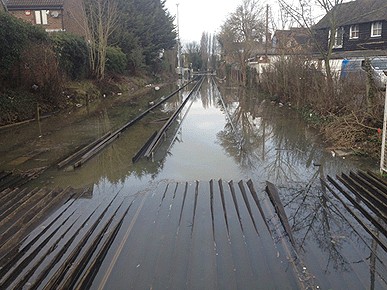In recent years the TV news schedules over the festive period have been dominated by flooding in the Thames Valley and Somerset Levels and 2015 was no different with the Environment Agency, Army and local residents filling our screens with their efforts to alleviate flooding.

On January 3, 2016, PM David Cameron announced over £40m to rebuild and improve flood defences following the aftermath of Storm Eva.
According to the department of energy and climate change (DECC), the funding takes investment in recovery from Storm Eva and Storm Desmond to nearly £200m.
There are, of course, many parts of the UK where localised flooding occurs and some may wonder whether the events of the past few years are a natural extension of this.
Not according to Oxford University’s Prof Myles Allan who believes weather has changed, society has changed and we’ll just have to get used to it.
“Those with more open minds are asking ‘is this the new normal’? Unfortunately, the answer is ‘no’ — ‘normal weather’, unchanged over generations apart from random fluctuations, is a thing of the past,” said Prof Allan. “When families reconvene for Christmas in the 2040s, the envelope of ’normal weather’ will have shifted by as much again as it has already shifted since the 1970s. Which means we increasingly rely on computer-simulated weather for long-range planning: an important point for those who still can’t resist sniping at our long-suffering Met Office.”
There will be those that vociferously disagree but many in the scientific community are citing climate change as a driver for these extreme events, reminding us that a warmer world is one likely to be wetter during the winter.
The question remains on how to deal with these frequently intense periods of rainfall and flooding, with some reminding government that the Foresight Review on Future Flooding (2004) and the Pitt Review (2007) provided scope to do so.
Is another root and branch review required to stem the tide of flooding? Maybe not, according to Colin Thorne, Professor and Chair of Physical Geography, School of Geography, Nottingham University, who said: “In my opinion the studies the government initiated in 2002 have already established what needs to be done to reduce the misery and economic costs due to future flooding that is becoming more frequent and severe.
“I also believe that the competent authorities are doing the right things: they just aren't doing them fast enough. On top of that, it seems that climate change is kicking-in quicker than Flood Foresight forecast it would back in 2004.
“I don't think we need another review: I think we need to accelerate implementation of responses to future flooding identified by the Flood Foresight Projects and envisaged in the comprehensive Catchment Flood Management Plans (CFMPs) that have already been worked out for every catchment in England and Wales. That does require investing more money in flood risk management, but the return on this type of investment is a good one - usually the benefit-cost ratio is about 6 to 1.
“We must spend that money wisely though - there is no 'silver bullet' that can prevent flooding entirely. We need to defend our cities, reduce the exposure of key infrastructure (especially electricity switching stations, water treatment plants etc.) and use a great deal more 'managed flooding' of farmland on floodplains to take more of the pressure off urban flood defences.”
The final word goes to Prof Andrew Watkinson, University of East Anglia, and author on Foresight Review on Flooding and contributor to Pitt Review, who said: “There is no single solution to the change in flood risk, but rather a portfolio of responses is required including strategic engineering works, changes in land and river management, modernising urban drainage systems and changes in land use planning. This requires a more integrated approach to flood risk management and an increase in funding.”
Scroll down to comment on this story.
Please note, you will need to complete our free registration process to comment on stories and to read other user's comments.





Red Bull makes hydrogen fuel cell play with AVL
Formula 1 is an anachronistic anomaly where its only cutting edge is in engine development. The rules prohibit any real innovation and there would be...